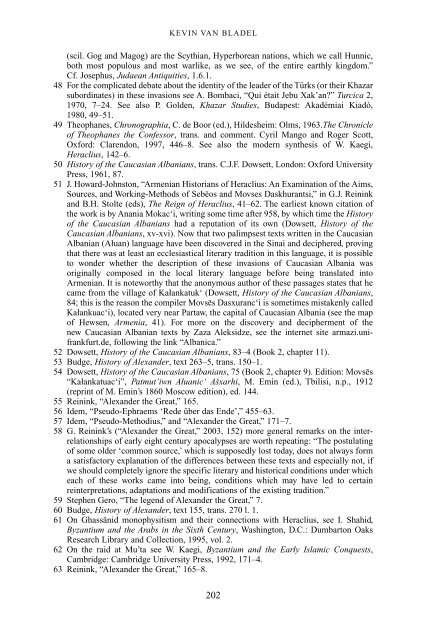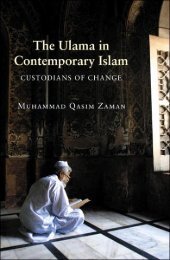The Qur'an in its historical context (pdf - Islam and Christian-Muslim ...
The Qur'an in its historical context (pdf - Islam and Christian-Muslim ...
The Qur'an in its historical context (pdf - Islam and Christian-Muslim ...
You also want an ePaper? Increase the reach of your titles
YUMPU automatically turns print PDFs into web optimized ePapers that Google loves.
KEVIN VAN BLADEL<br />
(scil. Gog <strong>and</strong> Magog) are the Scythian, Hyperborean nations, which we call Hunnic,<br />
both most populous <strong>and</strong> most warlike, as we see, of the entire earthly k<strong>in</strong>gdom.”<br />
Cf. Josephus, Judaean Antiquities, 1.6.1.<br />
48 For the complicated debate about the identity of the leader of the Türks (or their Khazar<br />
subord<strong>in</strong>ates) <strong>in</strong> these <strong>in</strong>vasions see A. Bombaci, “Qui était Jebu Xak’an?” Turcica 2,<br />
1970, 7–24. See also P. Golden, Khazar Studies, Budapest: Akadémiai Kiadó,<br />
1980, 49–51.<br />
49 <strong>The</strong>ophanes, Chronographia, C. de Boor (ed.), Hildesheim: Olms, 1963.<strong>The</strong> Chronicle<br />
of <strong>The</strong>ophanes the Confessor, trans. <strong>and</strong> comment. Cyril Mango <strong>and</strong> Roger Scott,<br />
Oxford: Clarendon, 1997, 446–8. See also the modern synthesis of W. Kaegi,<br />
Heraclius, 142–6.<br />
50 History of the Caucasian Albanians, trans. C.J.F. Dowsett, London: Oxford University<br />
Press, 1961, 87.<br />
51 J. Howard-Johnston, “Armenian Historians of Heraclius: An Exam<strong>in</strong>ation of the Aims,<br />
Sources, <strong>and</strong> Work<strong>in</strong>g-Methods of Sebeos <strong>and</strong> Movses Daskhurantsi,” <strong>in</strong> G.J. Re<strong>in</strong><strong>in</strong>k<br />
<strong>and</strong> B.H. Stolte (eds), <strong>The</strong> Reign of Heraclius, 41–62. <strong>The</strong> earliest known citation of<br />
the work is by Anania Mokac‘i, writ<strong>in</strong>g some time after 958, by which time the History<br />
of the Caucasian Albanians had a reputation of <strong>its</strong> own (Dowsett, History of the<br />
Caucasian Albanians, xv-xvi). Now that two palimpsest texts written <strong>in</strong> the Caucasian<br />
Albanian (A„uan) language have been discovered <strong>in</strong> the S<strong>in</strong>ai <strong>and</strong> deciphered, prov<strong>in</strong>g<br />
that there was at least an ecclesiastical literary tradition <strong>in</strong> this language, it is possible<br />
to wonder whether the description of these <strong>in</strong>vasions of Caucasian Albania was<br />
orig<strong>in</strong>ally composed <strong>in</strong> the local literary language before be<strong>in</strong>g translated <strong>in</strong>to<br />
Armenian. It is noteworthy that the anonymous author of these passages states that he<br />
came from the village of Ka„ankatuk‘ (Dowsett, History of the Caucasian Albanians,<br />
84; this is the reason the compiler Movses Dasxuranc‘i is sometimes mistakenly called<br />
Ka„ankuac‘i), located very near Partaw, the capital of Caucasian Albania (see the map<br />
of Hewsen, Armenia, 41). For more on the discovery <strong>and</strong> decipherment of the<br />
new Caucasian Albanian texts by Zaza Aleksidze, see the <strong>in</strong>ternet site armazi.unifrankfurt.de,<br />
follow<strong>in</strong>g the l<strong>in</strong>k “Albanica.”<br />
52 Dowsett, History of the Caucasian Albanians, 83–4 (Book 2, chapter 11).<br />
53 Budge, History of Alex<strong>and</strong>er, text 263–5, trans. 150–1.<br />
54 Dowsett, History of the Caucasian Albanians, 75 (Book 2, chapter 9). Edition: Movses<br />
“Ka„ankatuac‘i”, Patmut’iwn A„uanic‘ Amxarhi, M. Em<strong>in</strong> (ed.), Tbilisi, n.p., 1912<br />
(repr<strong>in</strong>t of M. Em<strong>in</strong>’s 1860 Moscow edition), ed. 144.<br />
55 Re<strong>in</strong><strong>in</strong>k, “Alex<strong>and</strong>er the Great,” 165.<br />
56 Idem, “Pseudo-Ephraems ‘Rede über das Ende’,” 455–63.<br />
57 Idem, “Pseudo-Methodius,” <strong>and</strong> “Alex<strong>and</strong>er the Great,” 171–7.<br />
58 G. Re<strong>in</strong><strong>in</strong>k’s (“Alex<strong>and</strong>er the Great,” 2003, 152) more general remarks on the <strong>in</strong>terrelationships<br />
of early eight century apocalypses are worth repeat<strong>in</strong>g: “<strong>The</strong> postulat<strong>in</strong>g<br />
of some older ‘common source,’ which is supposedly lost today, does not always form<br />
a satisfactory explanation of the differences between these texts <strong>and</strong> especially not, if<br />
we should completely ignore the specific literary <strong>and</strong> <strong>historical</strong> conditions under which<br />
each of these works came <strong>in</strong>to be<strong>in</strong>g, conditions which may have led to certa<strong>in</strong><br />
re<strong>in</strong>terpretations, adaptations <strong>and</strong> modifications of the exist<strong>in</strong>g tradition.”<br />
59 Stephen Gero, “<strong>The</strong> legend of Alex<strong>and</strong>er the Great,” 7.<br />
60 Budge, History of Alex<strong>and</strong>er, text 155, trans. 270 l. 1.<br />
61 On Ghassanid monophysitism <strong>and</strong> their connections with Heraclius, see I. Shahid,<br />
Byzantium <strong>and</strong> the Arabs <strong>in</strong> the Sixth Century, Wash<strong>in</strong>gton, D.C.: Dumbarton Oaks<br />
Research Library <strong>and</strong> Collection, 1995, vol. 2.<br />
62 On the raid at Mu’ta see W. Kaegi, Byzantium <strong>and</strong> the Early <strong>Islam</strong>ic Conquests,<br />
Cambridge: Cambridge University Press, 1992, 171–4.<br />
63 Re<strong>in</strong><strong>in</strong>k, “Alex<strong>and</strong>er the Great,” 165–8.<br />
202



